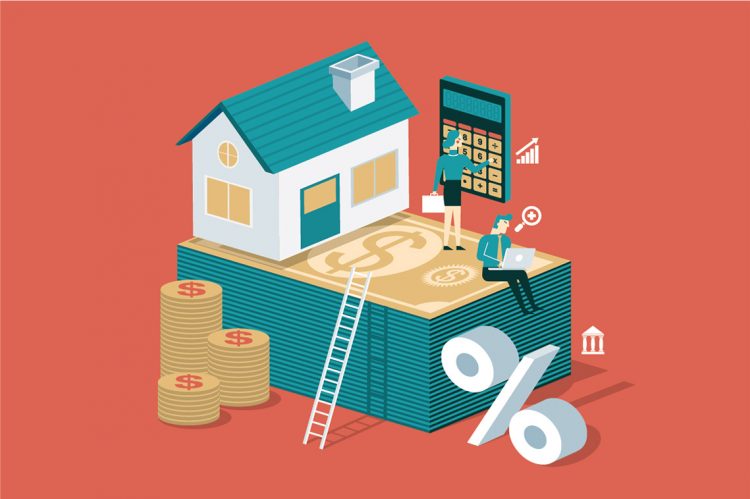As the housing affordability crisis persists, aspiring homeowners have developed a larger appetite for riskier mortgage products that can lighten the load of the growing expense associated with purchasing a home.
That has been evident in the adjustable-rate mortgage (ARM) market, as experts say they’ve seen a significant uptick in their popularity among borrowers this year compared to 2021.
“The main reason they are becoming much more popular now is that usually, they offer lower introductory rates than fixed-rate mortgages do,” says Jacob Channel, a senior economist at LendingTree who authored a recent report showing that the amount of ARMs offered to its users more than tripled in the first half of 2022 compared to the same period last year—up 230%
Experts tell RISMedia that ARMs have made a significant comeback in the past decade.
According to Joel Kan, associate vice president of Economic and Industry Forecasting for the Mortgage Bankers Association (MBA), LendingTree’s report is indicative of a more significant trend taking hold in the lending industry as well.
Based on MBA data, the share of ARM applications has settled between 9% and 11% of all mortgage applications in recent months compared to the 3% share it had during 2020 and 2021 when the refinance market boomed under record-low mortgage rates.
As mortgage rates climbed from 3% to nearly 6% in the first half of the year, Kan says the shift toward ARMs indicates that borrowers are looking to remain competitive while keeping monthly payments relatively low.
That’s been the case for mortgage broker Shant Banosian of Guaranteed Rate, who says that he and his team have been having more conversations about adjustable-rate loans than they have in a long time.
“It’s become sensible and strategic,” Banosian says. “We’re having a lot of those conversations, and we’re finding that a lot of our clients are using products like seven-year and 10-year ARMs in replacement of using a 30-year fixed-rate loan.”
That’s mainly due to the runup of borrowing costs and home prices in the past couple of years. The share of ARMs during 2020 and 2021 was negligible compared to the boom that refinancing and traditional 30-year fixed-rate loans saw while mortgage rates were still at record lows.
That’s changed significantly this year, as potential buyers are looking to borrow cheaper to remain in the market and compete, according to Banosian.
“Many people, especially first-time homebuyers, are not going to stay in these houses for 20 or 30 years anyways,” he says. “The thought is to use the seven- or 10-year ARM if it makes sense and if it’s something you can be comfortable with. And if the opportunity presents itself, or if rates come down in the future, consider refinancing.”
While ARMs have become more common this year than last year, Channel says they still pale compared to fixed-rate mortgages, which still account for the lion’s share of purchase originations. LendingTree’s report indicated that nearly 11 30-year, fixed-rate mortgages are offered for every 30-year ARM.
“This means that borrowers are still much more likely to get offered a fixed-rate mortgage than an ARM,” Channel stated in the report. “That said, about 41 fixed-rate mortgages were offered for every one adjustable-rate mortgage in the first half of 2021, so the popularity gap is shrinking.”
Remembering the crash
For those who remember the 2008 financial crisis—and some of the factors that caused it—the rise of adjustable-rate mortgages may evoke mixed feelings.
At that time, ARMs accounted for 42% of all new mortgage originations before nosediving after the financial downturn. That’s not far from MBA data, which places the share peak at 36% in March 2005.
The share hovered around 10% or below from 2009 through 2021.
According to Rick Sharga, executive vice president of market intelligence for ATTOM Data Solutions, ARMs make sense for the “right kind of borrower and the right situation.”
“It’s important for borrowers to understand the potential risks of taking an adjustable-rate mortgage,” Sharga says.
They were a popular product before the housing market collapse; however, many borrowers that got adjustable-rate loans back then because of their low introduction rates ended up defaulting when the rates rose, leading to a ripple effect that dragged the global economy down.
Experts agree that the current market has come a long way since the days of the 2008 crash, specifically when it comes to the lending standards and regulations surrounding ARMs.
“The lending standards and the environment where these ARMs are being given is just a little bit better than what it was prior to the Great Recession,” Channel says.
Sharga also noted that qualified mortgage rules from the financial crisis helped mitigate unnecessary risks that came back to bite consumers during the Great Recession.
In particular, most adjustable-rate products are capped at how high rates can be raised at the first adjustment and throughout the loan’s lifetime based on the Consumer Financial Protection Bureau (CFPB) standards.
According to the CFPB, the first rate change typically can’t go above 2% of the original rate, while the cap over the loan’s lifetime typically sits at about a 5% increase.
“It was a very different scenario than we are in today when people are making reasonable down payments on properties in many cases,” Sharga says.
Homeowners’ equity also provides a safeguard for borrowers as home prices have surged in the past year and a half. According to Sharga, there is $27 trillion of homeowner equity in today’s market, which is vastly different from the last economic cycle.
“The conditions we had 10 years ago are nothing like the conditions that we are seeing today,” he says. “There is some risk involved anytime you take out a loan to buy a house. The only risk you’re looking at right now is if rates go up during that period before your first adjustment.”
Still risky
Despite the safeguards designed to protect borrowers from being overwhelmed by the rate change, the nature of an adjustable-rate mortgage is still inherently riskier than a fixed-rate product.
At the moment, an ARM-fueled collapse is unlikely, but Channel says that over the next several years, that could change if it balloons into another problem as it did in the early 2000s.
“A lot of the people who are getting ARMs right now are probably not going to see their rates change for the next five years, so there are multiple years of leeway, and certainly nobody knows where rates will be six months from now, let alone five years from now,” Channel says.
“It’s worth pointing out that what led to the housing collapse last time was good intentions turned into something unsustainable,” Channel says. “There was this real push to make homeownership more accessible and to make it so lenders could give more loans to more people, and that did help some people.”
According to Channel, if home prices remain steep and rates remain elevated or climb higher over the next decade, there could be a similar push by the government agencies and lenders to become more permissive with borrowers.
“You can very quickly find yourself on a slippery slope back to what got us into trouble last time, and I think there is potential for ARM to be a part of that issue again,” he adds.












